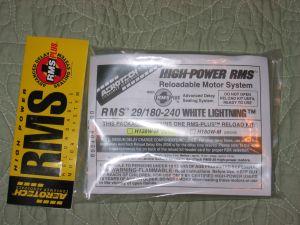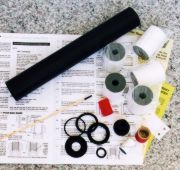| Manufacturer: | Aerotech  |

Brief:
The AeroTech H123W-M is a high power rocket motor reload. This is arguably the most popular reload used for certifying Level 1 with because of its general easy availability, low cost, and that so many rockets perform well with this particular motor. You must be Level 1 certified (as recognized by NAR, Tripoli, and/or CAR) to purchase and use one of these reloads.
Construction:
The reload includes the following parts:
- 1 nozzle
- 1 paper liner
- 2 propellant grains
- 1 aft O-ring, 3/16" thick x 1-3/8" diameter
- 1 forward O-ring, 1/8" thick x 1-3/8" diameter
- 1 delay O-ring, 3/32" thick x 5/8" diameter
- 1 delay element
- 1 neoprene delay element
- 2 fiber washer insulators
- 1 delay spacer ring
- 1 FirstFire ignitor
- 1 ejection charge (red cap)

Other items needed:
- AeroTech or Dr. Rocket 38/240 casing with closures
- O-ring lubricant
- masking tape
- paper towels
- clean work area
- large dowel
Assembling the reload is fairly straight ahead and the overall design with AeroTech reloads scale up throughout their entire line so the process remains similar, just the size of the reload components increase or decrease in size. Aside from the included instructions full of excellent diagrams in the package, there are videos on the AeroTech website that do a super job of walking you through assembling a reloadable motor. Either watching an experienced high power rocketeer assemble a reload or having an experienced person guide you through the assembly is very helpful too. A first timer should be able to assemble the motor in less than 10 minutes and once you get the hang of it, will take easily half as much time.
 Perhaps the most important thing to do when assembling the motor is to have clean hands and a dirt free workspace. As little as a grain of sand on an O-ring can cause an improper seal resulting in a motor CATO and potential damage to the rocket. It is worth mentioning that experienced high power rocketeers have varying opinions regarding what brand or kind of lubricant as well as how much to apply--if any at all!--when assembling their motors. That discussion is outside the scope of this review so I encourage you to search online and ask your fellow club members to see what works best for them before deciding for yourself. (I happen to be one of those that does not use any lubricants but religiously clean my casings as soon as they are cool enough to handle at the field.)
Perhaps the most important thing to do when assembling the motor is to have clean hands and a dirt free workspace. As little as a grain of sand on an O-ring can cause an improper seal resulting in a motor CATO and potential damage to the rocket. It is worth mentioning that experienced high power rocketeers have varying opinions regarding what brand or kind of lubricant as well as how much to apply--if any at all!--when assembling their motors. That discussion is outside the scope of this review so I encourage you to search online and ask your fellow club members to see what works best for them before deciding for yourself. (I happen to be one of those that does not use any lubricants but religiously clean my casings as soon as they are cool enough to handle at the field.)
With the motor assembled and ready to go inside the rocket, not to mention that depending on what kind of motor retention is used on the rocket, masking tape may be needed to ensure that the motor is held safely inside the rocket motor mount tube. With the FirstFire ignitor, it should be OK to install the ignitor in the motor before taking the rocket out to the pad as long as you do not strip the ends of the wires until the rocket is placed on the pad. It would be a good idea to check with the LCO first to ensure that you are following all club policies and rules (as I have found that some clubs have stricter rules than those dictated by the national organizations).
Flight:
A 12V launcher is required to ensure that there is a strong enough charge to fire the ignitor. Enjoy the flight as you've worked hard to get the rocket up in the air!
Recovery:
AeroTech motors have 3 different delay times available for their reloads. The reloads include the medium (10 second) delay grain with the motor but RMS-Plus RDK kits are available separately so that you can have a short (6 second) or long (14 second) delay. Each RMS-Plus RDK kit comes with 3 delays of the desired type and are only available for use with certain AeroTech reloads. Check the RMS-Plus RDK packaging for more information. Much like the reload kits themselves, it is a good idea to not open any of the internal packaging in the RMS-Plus RDK kits until ready for use.
Also, a common recovery failure (that thankfully does not happen very often) is due to the black powder charge coming out of the top of the motor. Masking tape around the end of the forward closure can prevent this. As well, in the rare instance where more black powder is required for ejection, masking tape can also be used to hold more over the charge well. Rocketeers' solutions for cleaning up the used motor casing are almost as varied as the aforementioned lubricant application. The important thing is that regardless of what cleaning solution used, it is in your best interest to clean the casing within 24 hours after each use. I will at the very least bring a watertight container with mild soap and water so that I can throw the casing in there and allow it to soak until I get home. That also gives me the option of cleaning it at the field if I want to use the casing multiple times in one afternoon as well. Again, checking with other club members might reveal other excellent ideas for handling cleaning up your motor casings!
Summary:
The AeroTech H123W-M is a popular Level 1 certification motor with good reasons: it is cheap, available, and versatile. While you save money on the cost of the reload, it does require an investment on the builder's part to assemble and clean up the motor when using it.
PROs:
- Longest burn time of any AeroTech H class motors with White Lightning propellant.
- Available through pretty much all high power motor vendors.
- Compatible with either AeroTech or Dr. Rocket motor hardware.
- Includes a FirstFire ignitor.
CONs:
- It has the lowest average thrust (an in turn, lowest max liftoff weight) of popular H reloadable motors available.
- Only three delays are available.
- Requires the purchase of RMS-Plus RDK kits to use the short or long delays.
- The motor hardware is expensive (MSRP is $160.95 for the Dr. Rocket 38/240-480 RMS system).
- It takes several minutes to assemble the motor and to clean up after use.
- Motor failures are commonly caused by an O-ring leak, which typically means that there was dirt on O-ring--user error!
Overall Rating: 4 out of 5
 |
 |
A.S. (June 7, 2008)
A.H. (June 25, 2008)
Steve Lindeman (August 10, 2015)
I'm seeing a 29mm reload as well. Just as confused.
Sponsored Ads
 |
 |












D.M. (May 20, 2008)